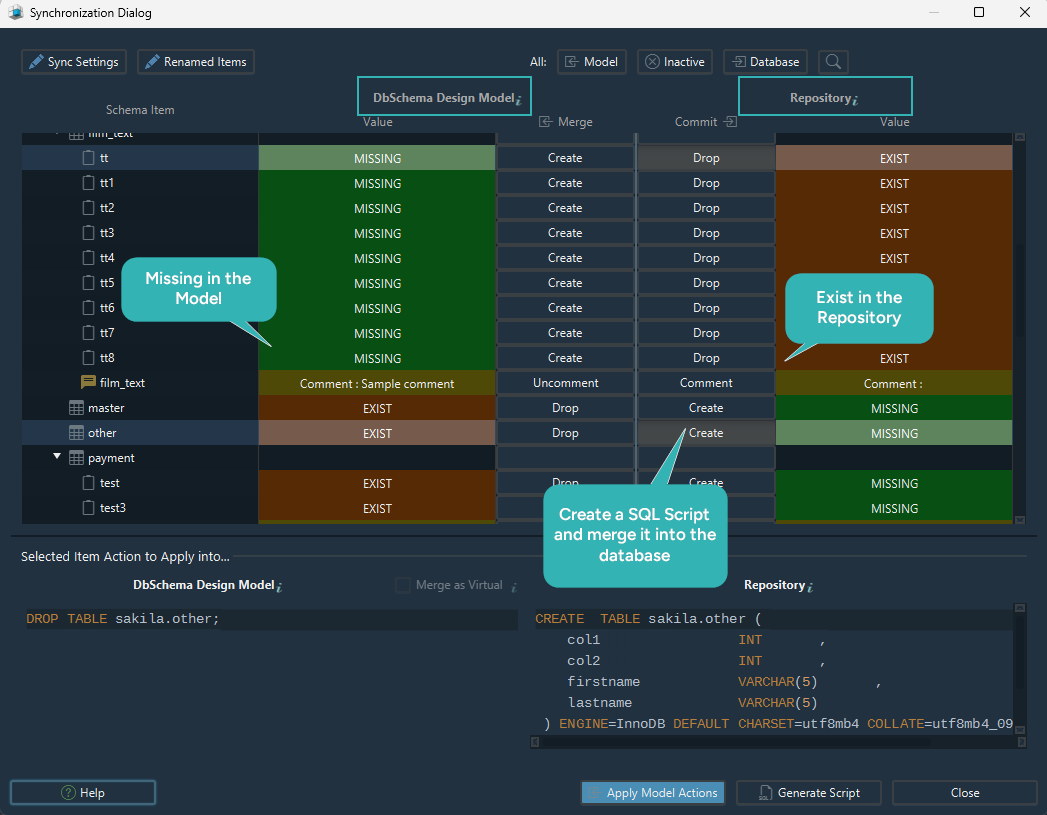
Best MySQL Database Design Tools in 2025

Planning a new MySQL project?
A good database design tool can help you move faster, stay organized, and avoid confusion later on.
Even if you’re sketching out your first schema or managing a production system, the right tool makes all the difference. From visual modeling to version control and team collaboration, there are great options available, and we’ve reviewed the top ones for 2025.
Tool Comparison Table
| Design Tool | Platform | Runs On | Pricing | Free Trial | Key Strength | Best For | Website |
|---|---|---|---|---|---|---|---|
 1. DbSchema 1. DbSchema |
Desktop | Windows, macOS, Linux | Free Community Edition; Pro: $19.60/month or $196 one-time |
30 days | Visual diagrams + Git + docs, and more | Schema design and documentation | Visit |
 2. MySQL Workbench 2. MySQL Workbench |
Desktop | Windows, macOS, Linux | Free (Community Edition) | N/A | Official MySQL support | Developers using MySQL only | Visit |
 3. dbForge for MySQL 3. dbForge for MySQL |
Desktop | Windows | Free Express Edition; Pro: $29.95/month or $199.95 one-time |
30 days | Feature-rich for MySQL | Professional MySQL projects | Visit |
 4. Navicat for MySQL 4. Navicat for MySQL |
Cross-platform | Windows, macOS, Linux | Subscription: $22.99/month; Perpetual: $1,299 | 14 days | UI + tools + modeling | Teams using multiple DBs | Visit |
 5. Dbvisualizer 5. Dbvisualizer |
Desktop | Windows, macOS, Linux | Free version available; Pro from $197 one-time or $49/month |
21 days | ER diagrams, SQL editor, multi-DB support | Developers needing a stable, multi-DB GUI tool | Visit |
 6. Dbeaver 6. Dbeaver |
Desktop | Windows, macOS, Linux | Free Community; Enterprise Edition from $25/month |
14-days | Cross-platform, broad DB support | Developers managing multiple databases | Visit |
 7. Lucidchart 7. Lucidchart |
Cloud | Browser-based | Lucidchart: Free plan; $9/month (Individual) |
7 days | UX and collaboration | Prototypes and brainstorming | Visit |
1. DbSchema
DbSchema is a mature design and management tool with over 15 years of development. It’s built to give developers and teams full visibility and control over their MySQL databases, with or without a live connection.
- Design visually - Create diagrams to organize tables and relationships, even without a live database.
- Compare schemas - Detect differences between database versions and keep environments in sync.
- Generate migration scripts - Create SQL scripts to update databases safely between changes.
- Explore your data - View related records across tables and filter data without writing joins.
- Build queries visually - Use drag-and-drop to create and run complex queries.
- Design Schema in the Team with Git - Work in teams and manage schema versions just like code.
- Generate test data - Fill your tables with random, structured sample data in seconds.
- Create interactive documentation - Export HTML5 docs that explain your schema and table details clearly.
Pros
- Works offline with schema design independent from the database, which is great for planning ahead or working remotely.
- Built-in Git integration for schema versioning - rare among database tools.
- HTML5 documentation lets your entire team (even non-developers) understand the structure without needing technical tools.
- Multi diagrams let you split large schemas into manageable views, which is ideal for complex systems.
Cons
- The interface has many tools, which may take a little time to discover, but once you do, they save a lot of effort.
- It’s a desktop app, so you won’t find it in your browser, but that also means its very secure and all your data stays within your system.
2. MySQL Workbench
MySQL Workbench is the official database tool developed by Oracle for working with MySQL. It’s free, widely used, and a solid choice if you want a tool that’s tightly integrated with the MySQL ecosystem.
- Model your database - Design your schema using EER diagrams with forward and reverse engineering.
- Manage users and permissions - Set up roles, control access, and manage security directly in the interface.
- Run and test SQL queries - Use the built-in SQL editor for writing and executing scripts.
- Visualize performance - Monitor server status and optimize queries with performance dashboards.
- Forward engineer - Generate database structures directly from your visual design.
- Reverse engineer - Import an existing database and turn it into a diagram automatically.
Pros
- Developed by the creators of MySQL, so compatibility and feature updates are reliable.
- Everything in one place: design, query, manage, and monitor your MySQL databases.
- Free and open source, ideal for students, solo developers, or anyone on a budget.
- Great choice if you’re already working closely with other Oracle tools or the MySQL command-line.
Cons
- Focused only on MySQL, which is perfect if you don’t need support for other databases.
- The interface is functional but a bit dated, though everything you need is there once you get used to it.
3. dbForge Studio
dbForge Studio is a feature-rich MySQL GUI tool by Devart, tailored for professional developers who want fine control over their databases. It combines database design, editing, and administration in one package.
- Design ER diagrams -> Visualize and edit database structure with forward and reverse engineering.
- Compare and sync schemas -> Spot differences between databases and generate precise migration scripts.
- Generate test data -> Fill tables with structured demo data for development or testing.
- Visual query builder -> Create complex SQL queries with a drag-and-drop interface.
- Automate tasks -> Schedule schema backups, exports, and report generation.
- Manage data and users -> Edit records directly, export data, and manage user roles visually.
Pros
- Offers one of the best schema comparison and synchronization tools on the market.
- Great for professionals who want to manage both structure and data in the same UI.
- Available in multiple editions, including a free Express version with limited features.
️ Cons
- Windows only, not ideal for macOS or Linux users.
- The interface is more technical, which is excellent for advanced users, but may feel overwhelming for beginners.
4. Navicat for MySQL
Navicat for MySQL is a premium database management tool designed for professionals who want a polished experience across multiple platforms. It covers everything from design to administration with a heavy focus on usability.
- Model database structures -> Create and edit tables and relationships in a visual diagram.
- Sync models and databases -> Compare and update schemas with precision.
- Export and import data -> Handle CSV, Excel, JSON, and more using built-in wizards.
- Automate tasks -> Schedule backups, data transfers, and reports with built-in job scheduling.
- Manage users and roles -> Handle MySQL user privileges through a friendly GUI.
- Build and run queries -> Use the built-in SQL editor with snippets, highlighting, and history.
Pros
- Iy’s polished and stable, feels like a premium product from installation to everyday use.
- Great support for team workflows with Navicat Cloud (sharing queries, connections, and models).
- One license can support MySQL, MariaDB, and others like Oracle or PostgreSQL (via Navicat Premium).
Cons
- Higher price compared to most competitors, better suited for enterprise or commercial use.
- While it supports diagrams, the design features are simpler than other tools focused on modeling only.
5. DbVisualizer
DbVisualizer is a stable and professional SQL tool used widely in both individual and enterprise environments. While it’s not a full data modeling platform, it gives you just enough to explore your schema and handle daily MySQL development efficiently.
- Visualize table relationships - Auto-generate ER diagrams from your schema to understand structure quickly.
- Edit and explore data - Browse, filter, and update table data without writing queries.
- Write and manage SQL - Full SQL editor with formatting, execution plans, and command history.
- Bookmark frequently used items - Save queries, tables, or procedures for quick access.
- Export results - Output query results to Excel, CSV, XML, and other formats with ease.
- Multi-database support - Connect to 50+ databases with built-in JDBC drivers, including MySQL, PostgreSQL, Snowflake, Redshift, and more.
Pros
- ER diagrams are auto-generated from live schemas, great for documentation or onboarding.
- Query editor includes performance insights and autocomplete, helpful for writing and optimizing SQL.
- Pro edition adds tools like charting, query scheduling, and advanced data comparison.
️ Cons
- Diagramming is limited to existing schemas, there’s no way to design a new structure visually or generate DDL scripts.
- No Git integration or schema versioning, DbVisualizer focuses on data exploration, not team-based modeling workflows.
6. DBeaver
DBeaver is a popular open-source SQL tool used by developers and analysts alike. It supports a wide range of databases and includes great features for both data management and basic database visualization.
- Reverse-engineer ER diagrams - Auto-generate diagrams from live databases for documentation or exploration.
- Browse and edit data - Easily filter, sort, and edit table data from the UI.
- Write and run SQL - Full-featured SQL editor with autocomplete, formatting, and execution plans.
- Visual query builder - Create queries using a drag-and-drop UI, ideal for non-SQL users.
- Data migration tools - Import/export CSV, Excel, and more; also includes data compare tools.
- Plugin system - Extend DBeaver with community or custom plugins for charts, Git integration, and more.
Pros
- Very flexible: supports over 80 databases via JDBC.
- Great community support and constant updates.
- Available as Free (Community) and Enterprise edition for advanced features like ERD export, mock data, and collaboration.
Cons
- Not focused on schema design, no forward engineering or diagram layouts.
- Some features like schema compare, data generator, or ERD export are only in the Enterprise version.
7. Lucidchart
Lucidchart is a browser-based diagramming tool that’s commonly used for creating flowcharts, process maps, and yes — ER diagrams. It’s not a database tool per se, but it’s useful for conceptual design, documentation, and team communication.
- Drag-and-drop ERD templates -> Use prebuilt shapes or import table definitions to build your schema manually.
- Collaborate in real time -> Share diagrams and leave comments like in Google Docs.
- Export to image or PDF -> Create clean visuals for presentations, documentation, or training.
- Database import (Pro feature) -> Import structure from SQL or CSV files to build ERDs quickly.
- Integrates with Google Drive, Confluence, and more -> Useful for documentation workflows.
Pros
- Super easy to use, which is great for teams that don’t want to learn technical tools.
- Real-time collaboration, version history, and comments.
- Perfect for early-stage design or documentation where visuals matter more than SQL code.
Cons
- Doesn’t connect live to your MySQL database (only import or manual drawing).
- No SQL generation, schema comparison, or Git/versioning tools.
So, Which Tool Deserves Your Time?
Database design isn’t just about drawing boxes and lines, it’s about choosing a tool that fits how you think, collaborate, and grow your project over time.
Whether you’re modeling on paper, editing live data, or syncing changes through Git, each of the tools covered here offers its own strengths. Some are flexible and open-source, others are polished and purpose-built.
And if you’re someone who likes to combine visual clarity with structure: diagrams, documentation, even version control, you might find that DbSchema quietly checks more features than you expected.
Most tools offer a free version or trial. Try a few. You’ll know pretty quickly which one helps you move faster, and that’s the one worth sticking with!

























